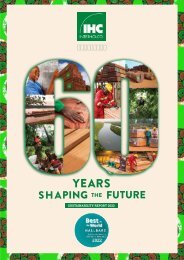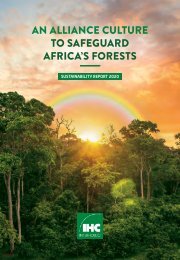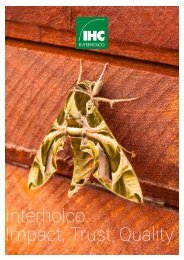Nomenclature Générale des Bois Tropicaux - 7ème édition
(english description below) Cette nomenclature est utilisée pour la mise à jour du 'Harmonized Code System' de l’Organisation Mondiale des Douanes. Dans la circulaire du 5 avril 2005, le Ministère de l’Economie, des Finances et de l’Industrie (France) reconnaît l’ATIBT comme « gardien du temple » de la nomenclature des bois tropicaux. La Commission Européenne mentionne la nomenclature de l’ATIBT comme document de référence pour la mise en œuvre du RBUE. Depuis 1954, l’ATIBT a établi et mis à jour une nomenclature des bois tropicaux faisant correspondre chaque espèce botanique avec un nom pilote reconnu internationalement. La détermination du nom pilote d’une essence est cruciale, car sa commercialisation dépend très largement de l’adoption de ce nom par le public. Le nom pilote assure la protection de l’appellation commerciale de l’essence et l’intégrité des propriétés qui lui sont attribuées, sans risque de confusion. The 1982 version of the general timber nomenclature has finally been updated as some of the 1,750 identified species, are no longer traded, while others, which were not previously included, are now on the market. The present revision has also integrated changes related to new taxonomy, in order to reflect the latest scientific developments. This Nomenclature has been used for the Harmonized Code System, updated by the World Customs Organization. The French Ministry of economy, finance and industry has given official recognition to ATIBT as the reference for the tropical timber nomenclature (NOR: PRMX0508285C of April 5th 2005). The European Commission refers to ATIBT nomenclature as a reference document for the implementation of the EUTR regulation. Since 1954, ATIBT has established and updated a nomenclature of tropical wood, linking each botanical species with an internationally recognized pilot name. A sigle wood species may have many common names; when trading across different countries, this may lead to confusion. Fixing the pilot name of a timber species is crucial, to protect the commercial denomination of the species and guarantee the veracity of the properties linked to that species, without confusion.
(english description below)
Cette nomenclature est utilisée pour la mise à jour du 'Harmonized Code System' de l’Organisation Mondiale des Douanes. Dans la circulaire du 5 avril 2005, le Ministère de l’Economie, des Finances et de l’Industrie (France) reconnaît l’ATIBT comme « gardien du temple » de la nomenclature des bois tropicaux. La Commission Européenne mentionne la nomenclature de l’ATIBT comme document de référence pour la mise en œuvre du RBUE.
Depuis 1954, l’ATIBT a établi et mis à jour une nomenclature des bois tropicaux faisant correspondre chaque espèce botanique avec un nom pilote reconnu internationalement. La détermination du nom pilote d’une essence est cruciale, car sa commercialisation dépend très largement de l’adoption de ce nom par le public. Le nom pilote assure la protection de l’appellation commerciale de l’essence et l’intégrité des propriétés qui lui sont attribuées, sans risque de confusion.
The 1982 version of the general timber nomenclature has finally been updated as some of the 1,750 identified species, are no longer traded, while others, which were not previously included, are now on the market. The present revision has also integrated changes related to new taxonomy, in order to reflect the latest scientific developments.
This Nomenclature has been used for the Harmonized Code System, updated by the World Customs Organization. The French Ministry of economy, finance and industry has given official recognition to ATIBT as the reference for the tropical timber nomenclature (NOR: PRMX0508285C of April 5th 2005). The European Commission refers to ATIBT nomenclature as a reference document for the implementation of the EUTR regulation.
Since 1954, ATIBT has established and updated a nomenclature of tropical wood, linking each botanical species with an internationally recognized pilot name. A sigle wood species may have many common names; when trading across different countries, this may lead to confusion. Fixing the pilot name of a timber species is crucial, to protect the commercial denomination of the species and guarantee the veracity of the properties linked to that species, without confusion.
Create successful ePaper yourself
Turn your PDF publications into a flip-book with our unique Google optimized e-Paper software.
Liste des noms pilotes des bois tropicaux avec renvoi aux noms scientifiques /// 79
PILOT NAME BOTANICAL NAMES COMMON NAMES
Olon
Olonvogo
Onzabili
Orey
Osanga
Zanthoxylum heitzii P.G. Waterman
(Syn. Fagara heitzii)
Zanthoxylum gilletii P.G. Waterman
(Syn. Fagara inaequalis)
(Syn. Fagara macrophylla)
(Syn. Fagara tessmanii)
Antrocaryon klaineanum Pierre
Antrocaryon micraster A. Chev.
Antrocaryon nannanii De Wild.
Antrocaryon spp.
Campnosperma gummifera L. March.
Campnosperma panamense Standl.
Campnosperma p.p. (AM)
Pteleopsis hylodendron Mildbr.
Pteleopsis myrtifolia Engl.
Bongo (CM) ; Kamasumu (CD) ; M’Banza (CG) ;
Olon (GA) ; Olong (GQ)
Bahé (CI) ; Bongo (CM) ; Nungu-Tsende (CD) ;
Olonvogo (GA)
Akoua (CI) ; Angonga (CM) ; Anguekong (GQ) ;
Aprokuma (GH) ; Gongu (CF) ; Mugongo (CD) ;
N’Gongo (AO, CG) ; Onzabili (GA)
Orey (BR, CO, CR, PA, VE) ; Sajo (CO)
Koframiré (CI) ; Osanga (CD) ; Sikon (CM)
Ossabel Dacryodes normandii Aubrev. & Pellegr. Koma (CG) ; Ossabel (GA)
Ossimiale
Ossoko
Ossol
Ovèngkol
Ovoga
Ozigo
Ozouga
Newtonia leucocarpa Gilbert & Boutique
(Syn. Piptadenia leucocarpa)
Scyphocephalium ochocoa Warb.
(Syn. Scyphocephalium mannii)
Symphonia globulifera L.
(Syn. Symphonia gabonensis)
Guibourtia ehie J. Léonard
Poga oleosa Pierre
Dacryodes buettneri H.J. Lam
(Syn. Pachylobus buettneri)
Sacoglottis gabonensis Urb.
Paco Ptaeroxylon obliquum Radlk. Paco (AO, ZA)
Padauk Amboina
Padauk Burma
Padouk d’Afrique
Paldao
Palissandre de Madagascar
Pterocarpus dalbergioides DC.
Pterocarpus indicus Willd.
(Syn. Pterocarpus vidalianus)
Pterocarpus macrocarpus Kurz
(Syn. Pterocarpus cambodianus)
(Syn. Pterocarpus pedatus)
Pterocarpus marsupium Roxb.
Pterocarpus osun Craib
Pterocarpus soyauxii Taub.
Pterocarpus tinctorius Welw.
Dracontomelum dao Merr. & Rolfe
(Syn. Dracontomelum edule)
(Syn. Dracontomelum mangiferum)
Dalbergia greveana Baill. *
Dalbergia monticola Bosser & R. Rabev.*
Dalbergia spp.
Nom atui (CM) ; Atui (GQ) ; Eseng (GQ) ; Ossimiale
(GA)
Akurna (CM) ; Eboukzok (CM) ; N’Suku (GA) ; Ossoko
(GA) ; Sogho (GA) ; Sorro (GA)
Muyanja (UG) ; Nianga-Nianga (CG) ; Nom-Onié
(CM) ; Ossol (GA) ; Tshilunga (CD)
Amazakoué (CI) ; Anokyé (GH) ; Guibourtia (NG) ;
Hyedua (GH) ; Hyeduanini (GH) ; Kaluk Afuon
(NG) ; Mbagna (CM) ; Ovèngkol (GA) ; Palissandro
(GQ)
Afo (GQ) ; Angalé (CM) ; Enoi (NG) ; Ohélé (CG) ;
Ovoga (GA)
Assas (CM) ; Assia (GA, GQ) ; Ozigo (GA)
Akouapo (CI) ; Atala (NG) ; Bidou (CM) ; Bodoua
(CM) ; Edoué (CM) ; Essoua (GA) ; Kpowuli (SL) ;
Niuka (CG) ; Ozouga (GA, GH) ; Tala (NG)
Amboina (ID ; Andaman Padauk (IN) ; Angsana
(ID) ; Linggua (ID) ; Manila-Padouk (PH) ; Narra
(PH) ; Pashu-Padauk (MM) ; Rosewood (PG) ; Sena
(MY) ; Sonokembang (ID) ; Vitali (PH)
Dang Huong (VN) ; Maidou (LA) ; Mai-Pradoo
(TH) ; Padauk Burma (MM) ; Padouk (MM) ; Pradoo
(TH) ; Thong (KH)
Kisésé (CG) ; M’Bèl (CM, GA) ; Mongola (CD) ;
Mukula (CD) ; N’Gula (CD) ; Osun (NG) ; Padouk
(CF) ; Palo rojo (GQ) ; Tacula (AO)
Dao (PH) ; Lamio (PH) ; Sengkulang (MY) ; Ulandug
(PH)
Manaribaomby (MG) ; Manariboraka (MG) ; Manaritoloho
(MG) ; Manary (MG) ; Mandoravy (MG) ;
Marariberavy (MG)














